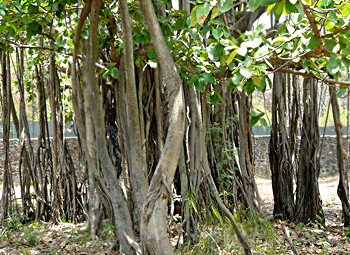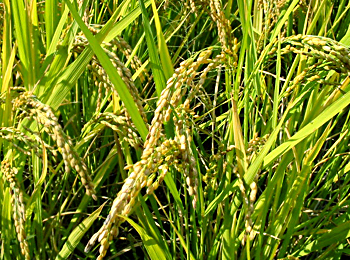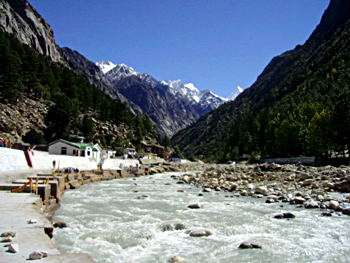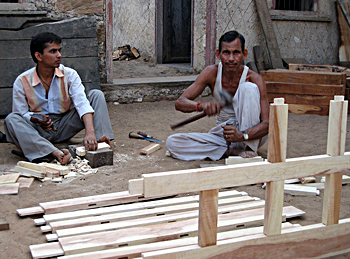 Context of the Rig Veda lies in the geographical and cultural conditions of the time during which these hymns were written. During the time when the hymns of the Rig Veda arose, the Aryans had not nearly as yet spread over the whole of India. They were still domiciled in the river-land of the Indus river (Sindhu), the present Punjab. From the West, over the passes of the Hindukush, Aryan tribes had penetrated into "the land of the five rivers," and in the songs of the Rig Veda we still hear of the battles which the Aryans had to fight with the Dasyu, or the `black skin`, as the swarthy aboriginal inhabitants were called. Only slowly amidst continuous fighting against the "non-Aryans", the Dasyus, do they press forward towards the East up to the Ganges.
Context of the Rig Veda lies in the geographical and cultural conditions of the time during which these hymns were written. During the time when the hymns of the Rig Veda arose, the Aryans had not nearly as yet spread over the whole of India. They were still domiciled in the river-land of the Indus river (Sindhu), the present Punjab. From the West, over the passes of the Hindukush, Aryan tribes had penetrated into "the land of the five rivers," and in the songs of the Rig Veda we still hear of the battles which the Aryans had to fight with the Dasyu, or the `black skin`, as the swarthy aboriginal inhabitants were called. Only slowly amidst continuous fighting against the "non-Aryans", the Dasyus, do they press forward towards the East up to the Ganges.
Geography in Rig Veda
It is a significant point to note that the great Indian River, the Ganga River, does not find much mention in the Rig Veda. Even the lotus-flower, which in a manner belongs to the essentials of later Indian poetry, is not yet a subject for metaphors among the Vedic singers. Altogether the animal and plant worlds in the Rig Veda are essentially different from those of later periods.
Flora and Fauna in Rig Veda
 The Indian fig-tree (Nyagrodha, Ficus indica) is missing in the Rig Veda. The tiger is not yet mentioned in the hymns, which probably means that they had not yet reached Bengal as Bengal was the home of the tigers then. The horse also was greatly valued and, harnessed before the chariot; bore the warrior to the field, and, at the popular chariot-races, gained praise and glory for the victor. Again and again in the songs and invocations to the gods, the prayer for cattle and horses occurs. Also the strife amongst the hostile aboriginal inhabitants turns on the possession of cattle. Therefore, too, the old word for "war" or "battle" is originally" desire for cattle" (Gavisti). Gods are readily compared with bullocks, goddesses with cows.
The Indian fig-tree (Nyagrodha, Ficus indica) is missing in the Rig Veda. The tiger is not yet mentioned in the hymns, which probably means that they had not yet reached Bengal as Bengal was the home of the tigers then. The horse also was greatly valued and, harnessed before the chariot; bore the warrior to the field, and, at the popular chariot-races, gained praise and glory for the victor. Again and again in the songs and invocations to the gods, the prayer for cattle and horses occurs. Also the strife amongst the hostile aboriginal inhabitants turns on the possession of cattle. Therefore, too, the old word for "war" or "battle" is originally" desire for cattle" (Gavisti). Gods are readily compared with bullocks, goddesses with cows.
Food in Rig Veda
Rice - later the chief product of agriculture and the staple food of the Indians- is still quite unknown to the Rig Veda. Only barley is planted, and at the time of the hymns agriculture as yet played only a small part. The milk of the cow was not only one of the chief articles of food, but milk and butter formed an essential part of the sacrifices to the gods. The milk was by preference consumed warm as it came from the cow, and Vedic poets marvel at the miracle that the "raw" cow gives cooked milk. However, the high esteem in which cattle were held proved no obstacle to the slaughtering of cows, and especially of bullocks, at the sacrifices, and to the eating of their flesh. An absolute prohibition of cow-killing did not exist in the oldest times, although the word "aghnya," "she who is not to be killed" for "cow" indicates that cows were killed only under exceptional circumstances.
Economy of Rig Veda
 The chief source of income was cattle-rearing, and the chief cattle were the bullock. Also the skin of the oxen was used. The tanner worked it up into leather bottles, strings of bows and straps. There were also already different kinds of industries. There was above all the wood worker- at once carpenter, carriage-builder, and cabinet-maker- who made especially the chariot. There were metal-workers, smiths, who used a bird`s wings as bellows. Shipping was still in its first beginnings. A canoe provided with oars, probably consisting only of a hollowed-out tree-trunk, served for the navigation of the rivers. Although the sea was known to the Vedic Indians, it is highly doubtful whether there was yet an extensive maritime trade. However, it is certain that there were traders and that an extensive trade was carried on, in which oxen and gold ornaments took the place of money. Besides oxen and horses, the Vedic singers implore the gods chiefly for gold, which they hope to receive as gifts from the rich sacrificers.
The chief source of income was cattle-rearing, and the chief cattle were the bullock. Also the skin of the oxen was used. The tanner worked it up into leather bottles, strings of bows and straps. There were also already different kinds of industries. There was above all the wood worker- at once carpenter, carriage-builder, and cabinet-maker- who made especially the chariot. There were metal-workers, smiths, who used a bird`s wings as bellows. Shipping was still in its first beginnings. A canoe provided with oars, probably consisting only of a hollowed-out tree-trunk, served for the navigation of the rivers. Although the sea was known to the Vedic Indians, it is highly doubtful whether there was yet an extensive maritime trade. However, it is certain that there were traders and that an extensive trade was carried on, in which oxen and gold ornaments took the place of money. Besides oxen and horses, the Vedic singers implore the gods chiefly for gold, which they hope to receive as gifts from the rich sacrificers.
Society in Rig Veda
There is found hardly any mention in the Rig Veda regarding caste division. Only in one single hymn, evidently late, are the four castes- Brahmin, Kshatriya, Vaishya and Sudras- mentioned. Certainly there were warriors and priests, but of an exclusive warrior-caste there is in the Rig Veda as little mention as of one or several lower castes of farmers, cattle-traders, merchants, artisans, and labourers. As in later times, so indeed already in the Rig Veda, it was the custom that, at the king`s side there stood a house-priest (Purohita) who offered the sacrifices for him. But there can still be seen often enough in the later Vedic period sacrifices and ceremonies, which the paterfamilias performs alone without priestly aid. The wife takes part in these sacrifices. In fact it is reckoned as absolutely essential, that the husband and wife together perform the sacred ceremonies. This participation of the wife in the sacrifices proves at all events that the position of woman in the oldest period of the Rig Veda was not yet so low as later, when the law-books absolutely forbid women to sacrifice.
In the Rig Veda we read of the married couple who "with minds in harmony press the Soma, rinse and mix it with milk" and offer adoration to the gods. In the hymns of the Rig Veda women could without restriction, at feasts, dances and such like, show themselves publicly. This does not just refer to courtesans but to all kinds of women.
 Thus from the contextual references in the Rig Veda, it can be made out that the Aryan Indians were an active, joyful and warlike people, of simple and still partly savage habits. The Vedic singers implore the gods for help against the enemy, for victory in battle, for glory and rich booty, they pray for wealth, heaps of gold and countless herds of cattle, for rain for their fields, for the blessing of children, and long life. Although the gulf which divides the hymns of the Rig Veda from the rest of Indian literature may perhaps not be as wide as many older investigators have supposed, a gulf still exists. This is proved by the language, by the cultural conditions indicated above, and most particularly by the stage of religious development, which we meet with in the hymns. So much is certain, that, whatever the poetical value of the songs of the Rig Veda may be, there exists no more important source for the investigation of the earliest stages in the development of Indian religion, no more important literary source for the investigation of the mythology of the Indo-European peoples, indeed, of peoples general, than these songs of the Rig Veda.
Thus from the contextual references in the Rig Veda, it can be made out that the Aryan Indians were an active, joyful and warlike people, of simple and still partly savage habits. The Vedic singers implore the gods for help against the enemy, for victory in battle, for glory and rich booty, they pray for wealth, heaps of gold and countless herds of cattle, for rain for their fields, for the blessing of children, and long life. Although the gulf which divides the hymns of the Rig Veda from the rest of Indian literature may perhaps not be as wide as many older investigators have supposed, a gulf still exists. This is proved by the language, by the cultural conditions indicated above, and most particularly by the stage of religious development, which we meet with in the hymns. So much is certain, that, whatever the poetical value of the songs of the Rig Veda may be, there exists no more important source for the investigation of the earliest stages in the development of Indian religion, no more important literary source for the investigation of the mythology of the Indo-European peoples, indeed, of peoples general, than these songs of the Rig Veda.



















